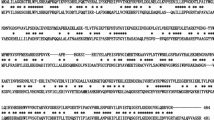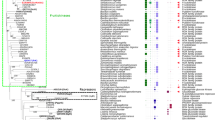Abstract
Thermotoga maritima TM0298 is annotated as an alcohol dehydrogenase, yet it shows high identity and similarity to mesophilic mannitol dehydrogenases. To investigate this enzyme further, its gene was cloned and expressed in Escherichia coli. The purified recombinant enzyme was most active on fructose and mannitol, making it the first known hyperthermophilic mannitol dehydrogenase. T. maritima mannitol dehydrogenase (TmMtDH) is optimally active between 90 and 100 °C and retains 63% of its activity at 120 °C but shows no detectable activity at room temperature. Its kinetic inactivation follows a first-order mechanism, with half-lives of 57 min at 80 °C and 6 min at 95 °C. Although TmMtDH has a higher V max with NADPH than with NADH, its catalytic efficiency is 2.2 times higher with NADH than with NADPH and 33 times higher with NAD+ than with NADP+. This cofactor specificity can be explained by the high density of negatively charged residues (Glu193, Asp195, and Glu196) downstream of the NAD(P) interaction site, the glycine motif. We demonstrate that TmMtDH contains a single catalytic zinc per subunit. Finally, we provide the first proof of concept that mannitol can be produced directly from glucose in a two-step enzymatic process, using a Thermotoga neapolitana xylose isomerase mutant and TmMtDH at 60 °C.






Similar content being viewed by others
References
Aarnikunnas J, Ronnholm K, Palva A (2002) The mannitol dehydrogenase gene (mdh) from Leuconostoc mesenteroides is distinct from other known bacterial mdh genes. Appl Microbiol Biotechnol 59:665–671
Albery W, Barlett P, Cass A, Sim K (1987) Amperometric enzyme electrodes. Part IV. An enzyme electrode for ethanol. J Electroanal Chem 218:127–134
Ausubel FM, Brent R, Kingston RE, Moore DD, Seidman JG, Smith JA, Struhl K (eds) (1993) In: Current protocols in molecular biology. Greene Publishing, New York
Banfield MJ, Salvucci ME, Baker EN, Smith CA (2001) Crystal structure of the NADP(H)-dependent ketose reductase from Bemisia argentifolii at 2.3 A resolution. J Mol Biol 306:239–250
Bardea A, Katz E, Buckmann AF, Willner I (1997) NAD-dependent enzyme electrodes electrical contact of cofactor dependent enzymes and electrodes. J Am Chem Soc 119:9114–9119
Bertini I, Luchinat C (1984) High spin cobalt(II) as a probe for the investigation of metalloproteins. Adv Inorg Biochem 6:71–111
Brünker P, Altenbuchner J, Kulbe KD, Mattes R (1997) Cloning, nucleotide sequence and expression of a mannitol dehydrogenase from Pseudomonas fluorescens DSM 50106 in Escherichia coli. Biochim Biophys Acta 1351:157–167
Carugo O, Argos P (1997) NADP-dependent enzymes. I: conserved stereochemistry of cofactor binding. Proteins 28:10–28
Chen T, Calabrese Barton S, Binyamin G, Gao Z, Zhang Y, Kim HH, Heller A (2001) A miniature biofuel cell. J Am Chem Soc 123:8630–8631
Gründig B, Wittstock G, Rüdel U, Strehlitz B (1995) Mediator-modified electrodes for electrocatalytic oxidation of NADH. J Electroanal Chem 395:143–157
Hahn G, Kaup B, Bringer-Meyer S, Sahm H (2003) A zinc-containing mannitol-2-dehydrogenase from Leuconostoc pseudomesenteroides ATCC 12291: purification of the enzyme and cloning of the gene. Arch Microbiol 179:101–107
Hunt JB, Neece SH, Schachman HK, Ginsburg A (1984) Mercurial-promoted Zn2+ release from Escherichia coli aspartate transcarbamoylase. J Biol Chem 259:14793–14803
Jaegfeldt H, Torstensson A, Gorton I, Johansson G (1981) Catalytic oxidation of reduced nicotinamide adenine dinucleotide by graphite electrodes modified with adsorbed aromatic containing catechol functionalities. Anal Chem 53:1979–1982
Jaenicke R (1991) Protein stability and molecular adaptation to extreme conditions. Eur J Biochem 202:715–728
Johnson MR, Conners SB, Montero CI, Chou CJ, Shockley KR, Kelly RM (2006) The Thermotoga maritima phenotype is impacted by syntrophic interaction with Methanococcus jannaschii in hyperthermophilic coculture. Appl Environ Microbiol 72:811–818
Jörnvall H, von Bahr-Lindstrom H, Jeffery J (1984) Extensive variations and basic features in the alcohol dehydrogenase-sorbitol dehydrogenase family. Eur J Biochem 140:17–23
Jörnvall H, Persson B, Jeffery J (1987) Characteristics of alcohol/polyol dehydrogenases. The zinc-containing long-chain alcohol dehydrogenases. Eur J Biochem 167:195–201
Karyakin AA, Bobrova OA, Karyakina EE (1995) Electroreduction of NAD+ to enzymatically active NADH at poly(neutral red) modified electrodes. J Electroanal Chem 399:179–184
Kaup B, Bringer-Meyer S, Sahm H (2005) d-Mannitol formation from d-glucose in a whole-cell biotransformation with recombinant Escherichia coli. Appl Microbiol Biotechnol 69:397–403
Korakli M, Vogel RF (2003) Purification and characterization of mannitol dehydrogenase from Lactobacillus sanfranciscensis. FEMS Microbiol Lett 220:281–286
Kulbe KD, Schwab U, Gudernatsch W (1987) Enzyme-catalyzed production of mannitol and gluconic acid. Product recovery by various procedures. Ann N Y Acad Sci 506:552–568
Laurinavicius V, Kurtinaitiene B, Gureviciene V, Boguslavsky L, Geng L, Skotheim T (1996) Amperometric glyceride biosensor. Anal Chem Acta 330:159–166
Le AS, Mulderrig KB (2001) Sorbitol and mannitol. In: O’Brien Nabors L (ed) Alternative sweeteners. Marcel Dekker, New York
Magonet E, Hayen P, Delforge D, Delaive E, Remacle J (1992) Importance of the structural zinc atom for the stability of yeast alcohol dehydrogenase. Biochem J 287:361–365
Munteanu FD, Kubota LT, Gorton L (2001) Effect of pH on the catalytic electrooxidation of NADH using different two-electron mediators immobilised on zirconium phosphate. J Electroanal Chem 509:2–10
Nordling E, Jörnvall H, Persson B (2002) Medium-chain dehydrogenases/reductases (MDR). Eur J Biochem 269:4267–4276
Ohtani M, Kuwabata S, Yoneyama H (1997) Electrochemical oxidation of reduced nicotinamide coenzymes at Au electrodes modified with phenothiazine derivative monolayers. J Electroanal Chem 422:45–54
Pariente F, Lorenzo E, Tobalina F, Abruna HD (1995) Aldehyde biosensor based on the determination of NADH enzymatically generated by aldehyde dehydrogenase. Anal Chem 67:3936–3944
Park DH, Zeikus JG (2003) Improved fuel cell and electrode designs for producing electricity from microbial degradation. Biotechnol Bioeng 8:348–355
Park DH, Laivenieks M, Guettler MV, Jain MK, Zeikus JG (1999) Microbial utilization of electrically reduced neutral red as the sole electron donor for growth and metabolite production. Appl Environ Microbiol 65:2912–2917
Park DH, Vieille C, Zeikus JG (2003) Bioelectrocatalysts: engineered oxidoreductase system for utilization of fumarate reductase in chemical synthesis, detection, and fuel cells. Appl Biochem Biotechnol 111:41–53
Prodomidis MI, Karayannis MI (2002) Enzyme based amperometric biosensors for food analysis. Electroanalysis 14:241–261
Puttick P, Vieille C, Song SH, Fodje MN, Grochulski P, Delbaere LTJ (2007) Crystallization, preliminary X-ray diffraction and structure analysis of Thermotoga maritima mannitol dehydrogenase. Acta Crystallogr F 63:350–352
Sasaki Y, Laivenieks M, Zeikus JG (2005) Lactobacillus reuteri ATCC 53608 mdh gene cloning and recombinant mannitol dehydrogenase characterization. Appl Microbiol Biotechnol 68:36–41
Schafer A, Stein MA, Schneider KH, Giffhorn F (1997) Mannitol dehydrogenase from Rhodobacter sphaeroides Si4: subcloning, overexpression in Escherichia coli and characterization of the recombinant enzyme. Appl Microbiol Biotechnol 48:47–52
Schneider KH, Giffhorn F (1989) Purification and properties of a polyol dehydrogenase from the phototrophic bacterium Rhodobacter sphaeroides. Eur J Biochem 184:15–19
Schneider KH, Giffhorn F, Kaplan S (1993) Cloning, nucleotide sequence and characterization of the mannitol dehydrogenase gene from Rhodobacter sphaeroides. J Gen Microbiol 139:2475–2484
Slatner M, Nidetzky B, Kulbe KD (1999) Kinetic study of the catalytic mechanism of mannitol dehydrogenase from Pseudomonas fluorescens. Biochemistry 38:10489–10498
Soetaert W, Buchholz K, Vandamme EJ (1995) Production of d-mannitol and d-lactic acid by fermentation with Leuconostoc mesenteroides. Agro Food Ind Hi Tech 6:41–44
Soetaert W, Vanhooren P, Vandamme E (1999) Production of mannitol by fermentation methods. Biotechnology 10:261–275
Sriprapundh D, Vieille C, Zeikus JG (2003) Directed evolution of Thermotoga neapolitana xylose isomerase: high activity on glucose at low temperature and low pH. Protein Eng 16:683–690
Stoop JM, Mooibroek H (1998) Cloning and characterization of NADP-mannitol dehydrogenase cDNA from the button mushroom, Agaricus bisporus, and its expression in response to NaCl stress. Appl Environ Microbiol 64:4689–4696
Tomazic SJ, Klibanov AM (1988) Mechanisms of irreversible thermal inactivation of Bacillus α-amylases. J Biol Chem 263:3086–3091
Vallee BL, Auld DS (1990) Zinc coordination, function, structure of zinc enzymes and other proteins. Biochemistry 29:5648–5659
Vallee BL, Galdes A (1984) The metallobiochemistry of zinc enzymes. Adv Enzymol Relat Areas Mol Biol 56:283–430
van der Donk WA, Zhao H (2003) Recent developments in pyridine nucleotide regeneration. Curr Opin Biotechnol 14:421–426
von Weymarn N, Kiviharju K, Leisola M (2002) High-level production of d-mannitol with membrane cell-recycle bioreactor. J Ind Microbiol Biotechnol 29:44–49
Willner I, Katz E (2000) Integration of layered redox proteins and conductive supports for bioelectronic applications. Angew Chem Int Ed 39:1180–1218
Woodyer R, van der Donk WA, Zhao H (2003) Relaxing the nicotinamide cofactor specificity of phosphite dehydrogenase by rational design. Biochemistry 42:11604–11614
Wu JT, Wu LH, Knight JA (1986) Stability of NADPH: effect of various factors on the kinetics of degradation. Clin Chem 32:314–319
Acknowledgment
This work was supported by the National Research Initiative of the United States Department of Agriculture’s Cooperative State Research, Education, and Extension Service, under grant number 2005-35504-16239. S. H. Song was supported in part by a grant from the Korea Research Foundation, Korean Government (MOEHRD; KRF-2006-214-D00050). L.T.J.D. is a Canada Research Chair in Structural Biochemistry. We thank Dr. J. G. Zeikus for his enthusiastic support and valuable discussions. We are grateful for the use of Dr. Jennifer Ekstrom’s chromatography system. We thank Dr. Joe Leykam and Dr. William Wedemeyer for their assistance with analytical ultracentrifugation and analytical ultracentrifugation data analysis, respectively. We thank Dr. R. M. Kelly from North Carolina State University for sending us a preculture of T. maritima.
Author information
Authors and Affiliations
Corresponding author
Rights and permissions
About this article
Cite this article
Song, S.H., Ahluwalia, N., Leduc, Y. et al. Thermotoga maritima TM0298 is a highly thermostable mannitol dehydrogenase. Appl Microbiol Biotechnol 81, 485–495 (2008). https://doi.org/10.1007/s00253-008-1633-9
Received:
Revised:
Accepted:
Published:
Issue Date:
DOI: https://doi.org/10.1007/s00253-008-1633-9




